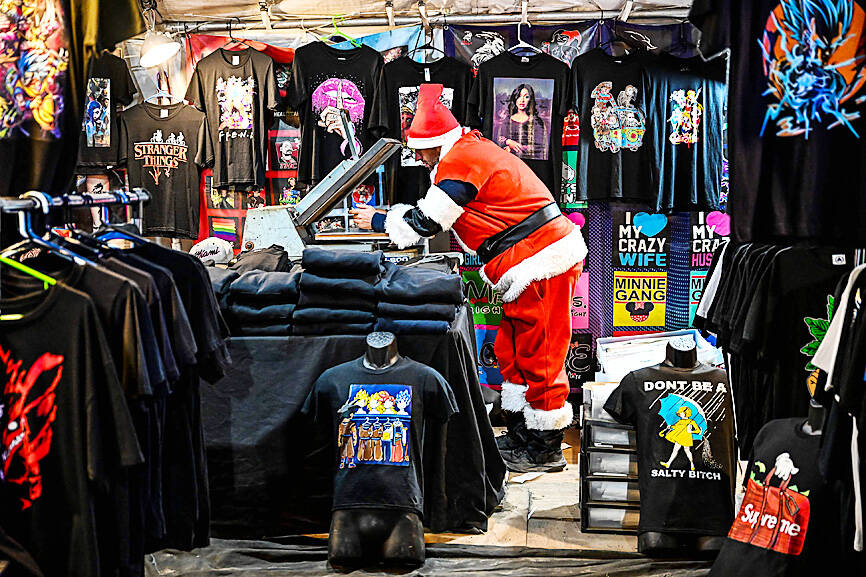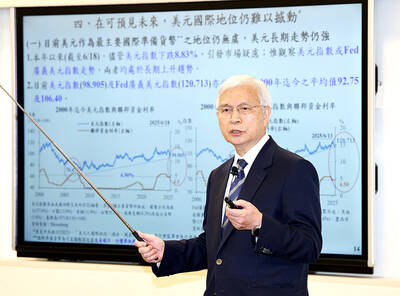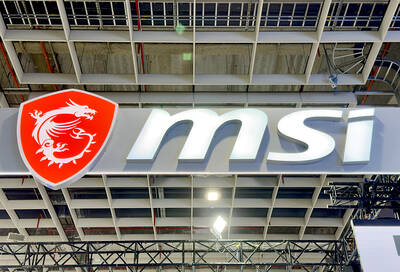Holiday sales rose this year as spending in the US remained resilient during the critical shopping season, despite surging prices on everything from food to rent.
Holiday sales rose 7.6 percent this year, a slower pace than the 8.5 percent increase of a year earlier when shoppers began spending the money they had saved during the early part of the COVID-19 pandemic, said Mastercard SpendingPulse, which tracks all kinds of payments including cash and debit cards.
Mastercard SpendingPulse had expected a 7.1 percent increase.

Photo: AFP
The data released on Monday excluded the automotive industry and was not adjusted for inflation, which has eased somewhat, but remains painfully high.
US sales between Nov. 1 and Dec. 24, a period that is critical for retailers, were fueled by spending at restaurants and on clothing.
By category, clothing rose 4.4 percent, while jewelry and electronics dipped about 5 percent. Online sales jumped 10.6 percent from a year earlier and in-person spending rose 6.8 percent. Department stores registered a modest 1 percent increase.
“This holiday retail season looked different than years past,” Steve Sadove, former Saks Inc chief executive and chairman and a senior adviser for Mastercard, said in a prepared statement. “Retailers discounted heavily, but consumers diversified their holiday spending to accommodate rising prices, and an appetite for experiences and festive gatherings post-pandemic.”
Some of the increase reflected the impact of higher prices.
Consumer spending accounts for nearly 70 percent of US economic activity, and Americans have remained resilient ever since inflation first spiked almost 18 months ago. However, cracks have begun to show, as higher prices for basic necessities take up an increasingly large share of everyone’s take-home pay.
Inflation has retreated from the four-decade high it reached in the summer, but it is still sapping the spending power of consumers. Prices rose 7.1 percent last month from a year earlier, down from a peak of 9.1 percent in June.
Overall spending has slowed from pandemic-infused splurges and shifted increasingly toward necessities such as food, while spending on electronics, furniture, new clothes and other non-necessities has faded.
Many shoppers have been trading down to private label goods, which are typically less expensive than national brands. They have been going to cheaper stores such as dollar chains and big-box stores such as Walmart Inc.
Consumers also waited for deals. Stores expected more procrastinators to hit the stores in the last few days before Christmas compared with a year earlier when people began shopping early due to a global disruption of the supply chain that created thousands of product shortages.
“Consumers are trying to spread out their budget, and they are evaluating and shopping at different stores,” Kearney’s Consumer Institute lead of consultancy Katie Thompson said.
Last month, shoppers cut back on retail spending compared with the previous month. Retail sales fell 0.6 percent from October after a sharp 1.3 percent rise the previous month, as sales fell at furniture, electronics, and home and garden stores, US government data showed.
A broader picture of how Americans spent their money arrives next month when the National Retail Federation, the nation’s largest retail trade group, comes out with its combined two-month results based on last month’s and this month’s sales data from the US Department of Commerce.
The trade group expects holiday sales growth would slow to a range of 6 to 8 percent, compared with the blistering 13.5 percent growth of a year earlier.

DIVIDED VIEWS: Although the Fed agreed on holding rates steady, some officials see no rate cuts for this year, while 10 policymakers foresee two or more cuts There are a lot of unknowns about the outlook for the economy and interest rates, but US Federal Reserve Chair Jerome Powell signaled at least one thing seems certain: Higher prices are coming. Fed policymakers voted unanimously to hold interest rates steady at a range of 4.25 percent to 4.50 percent for a fourth straight meeting on Wednesday, as they await clarity on whether tariffs would leave a one-time or more lasting mark on inflation. Powell said it is still unclear how much of the bill would fall on the shoulders of consumers, but he expects to learn more about tariffs

NOT JUSTIFIED: The bank’s governor said there would only be a rate cut if inflation falls below 1.5% and economic conditions deteriorate, which have not been detected The central bank yesterday kept its key interest rates unchanged for a fifth consecutive quarter, aligning with market expectations, while slightly lowering its inflation outlook amid signs of cooling price pressures. The move came after the US Federal Reserve held rates steady overnight, despite pressure from US President Donald Trump to cut borrowing costs. Central bank board members unanimously voted to maintain the discount rate at 2 percent, the secured loan rate at 2.375 percent and the overnight lending rate at 4.25 percent. “We consider the policy decision appropriate, although it suggests tightening leaning after factoring in slackening inflation and stable GDP growth,”

Meta Platforms Inc offered US$100 million bonuses to OpenAI employees in an unsuccessful bid to poach the ChatGPT maker’s talent and strengthen its own generative artificial intelligence (AI) teams, OpenAI CEO Sam Altman has said. Facebook’s parent company — a competitor of OpenAI — also offered “giant” annual salaries exceeding US$100 million to OpenAI staffers, Altman said in an interview on the Uncapped with Jack Altman podcast released on Tuesday. “It is crazy,” Sam Altman told his brother Jack in the interview. “I’m really happy that at least so far none of our best people have decided to take them

PLANS: MSI is also planning to upgrade its service center in the Netherlands Micro-Star International Co (MSI, 微星) yesterday said it plans to set up a server assembly line at its Poland service center this year at the earliest. The computer and peripherals manufacturer expects that the new server assembly line would shorten transportation times in shipments to European countries, a company spokesperson told the Taipei Times by telephone. MSI manufactures motherboards, graphics cards, notebook computers, servers, optical storage devices and communication devices. The company operates plants in Taiwan and China, and runs a global network of service centers. The company is also considering upgrading its service center in the Netherlands into a